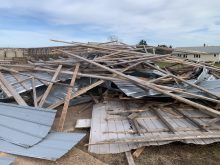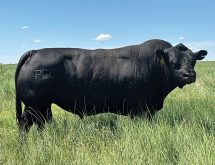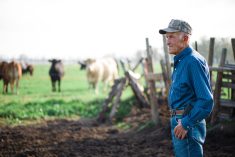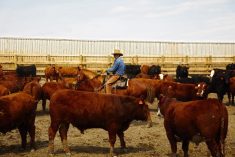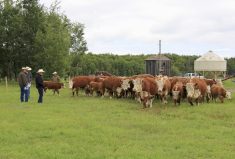Cattle followed gold prospectors to the Yukon in the late 1800s but not without countless mishaps and setbacks. Many unsuccessful attempts were made before cattle became a permanent fixture on the Yukon’s subarctic landscape. To this day, raising cattle in the Yukon comes with unique challenges, but several farmers have boldly accepted that challenge and continue to supply the market with high-quality, locally produced beef.
These northern cattlemen and women will tell you that hearty, rustic breeds such as Angus, Hereford and Luing are key to the success of their operations. With good-quality feed and pastureland at a premium, the efficiency of these cattle allows producers to be more profitable. These breeds also lend themselves well to the growing trend of primarily grass-fed beef, which is the preference of more and more Yukon consumers.
Read Also

A strategic approach to risk on the ranch
Given the increase in the value of livestock and the market volatility, we need to cover our risks. First,…
Diversity a mainstay of Yukon beef farms
One thing Yukon agriculturalists have in common is the diversity of their farming operations. Bill and Barbara Drury of Circle D Ranch are a prime example. For nearly 50 years, the Drury family has been farming on the banks of the picturesque Takhini River near Whitehorse, Yukon. There they raise grass-fed beef, elk, chickens and pigs, tend their large haskap berry orchard and produce kale for commercial kale chip production.
Barbara Drury remembers their start to raising cattle over 30 years ago which seemed to happen by fate.
“It’s kind of a funny story,” she says, “We’re along the Alaska Highway and the truckers were familiar with our farm. There was this one truck driver who was hauling bred Holstein heifers to a dairy in Alaska. He needed to unload them and give them a break since they were heavy in calf so he dropped them in our corrals for the night. By golly, that night one of the heifers had a calf. She was a little black heifer calf that was half Angus.”
Having no way to safely transport the calf for the remainder of the journey, the truck driver offered the calf to the Drury’s along with a bottle and a bag of milk replacer.
“So here we are raising this little calf,” says Drury. “She became our milk cow and she was a darling.”
Deciding their lone heifer calf needed some company, the Drurys purchased five purebred Black Angus cows and a bull from a breeder near Fort St. John, B.C. “And then we were in the beef business,” she laughs.
They chose Angus at that time because it was a good, balanced breed that was widely recognized as consistently producing high-quality beef. Today they still have an Angus-based herd. When it comes to calving time, Drury says, “We like proven cows, good cows who can pretty much do it in their sleep and these Angus cows do.”
Different from some of the beef producers in the area, the Drurys opt to keep only a small herd of mother cows to calve out each spring, beginning in mid-April. To fill the additional demand for beef from their customers, they then bring up a group of yearlings from B.C.’s Peace region each year. This allows them to use their summer pasture efficiently and save on prohibitive winter-feeding costs.
Any way you figure it, winter feed is going to cost you. Any local hay or silage is expensive as a result of the added trucking cost on fuel and equipment. Even producing winter feed for their own livestock is a challenge compared to less remote areas of the country. The window for putting up good hay is small and parts to repair equipment are not readily available.
“We can source hay from the Peace River region for a really reasonable price but the trucking triples that, landing it here at close to $300 per ton,” says Drury.
She cites abattoir availability as the Yukon beef sector’s biggest bottleneck, along with a shortage of quality butchering options. After experiencing a great deal of frustration securing quality butchering for their animals on a consistent basis, the Drurys decided to set up their own on-farm butchering facility.
At the time Drury said to her husband, Bill, “We need our own butcher shop if we’re going to continue on in this beef business. We can’t be raising this really good beef and not be able to have it cut and wrapped properly.”
This season alone the two of them, with the part-time help of a young local butcher, processed 15 head of cattle, five elk and five pigs.
Mobile abattoir a good option
With only one fixed-based abattoir in the Yukon and the need for government inspection, local beef producers have limited capability to supply the growing demand. An integral part of the solution lies in the addition of the mobile abattoir.

“The mobile abattoir is operated under inspection on a contract from the Yukon Government,” says Simone Rudge who, along with her husband Tim, currently holds the contract to operate the unit. Interested parties can submit a bid when the contract comes up for tender every three years.
“The contract is awarded on a number of factors, including experience and cost to the government,” Rudge says.
The Rudge family, who also own Aurora Mountain Farm, began operating the mobile abattoir in 2014. Operation typically runs from mid-April to mid-October processing upwards of 300 animals per year including beef, swine, sheep, elk and bison.
“Our regular day maximums are five beef, 10 pigs or 12 sheep. If multiple species are to be harvested in a single day, those maximums might be reduced to allow time for the extra cleaning and setup required,” says Rudge.
At the end of each day, the unit transports the carcasses to various butchering facilities for aging and cut-and-wrap services.
“Last year, our other business, Tum Tum’s Black Gilt Meats, opened a small butcher shop but the cut-and-wrap is completely separate from the mobile abattoir operations. The farmer is responsible for choosing and making appointments with a cut-and-wrap shop,” she says.
Daily operation of the mobile abattoir service requires two or three people, along with the government-certified meat inspector. In the past, this typically included Tim, Simone and their son, but this season they were able to hire a helper and operate the unit with just two people.
“The farmer also plays a role in abattoir operations,” Rudge says. Normally, two people from the farm are on hand to shoot the animal and move it to the back of the mobile abattoir trailer where the Rudges begin their work.
It is not uncommon for the mobile abattoir to travel 100-plus kilometres per day. “Most of the cattle are concentrated around Whitehorse,” says Rudge, but they travel throughout the Territory to places like Haines Junction and Dawson City, servicing swine producers as well.
Colder winter weather is the main limiting factor for the unit.
“Once we get overnight temperatures below 10 C, the constraints on keeping the unit thawed and running are quite high. Ice on the floors constitutes a safety hazard and there are challenges with keeping water flowing once temperatures are regularly below freezing,” says Rudge.
Direct sales offer best value
“We’re not as huge as you producers down south in terms of an industry,” notes Barbara Drury of Circle D Ranch, “but there are a growing number of us up here raising cattle.”
This is largely due to an increase in demand for local product in the Yukon. “It is a really good thing for the local producer.”
Bill and Barbara are careful to base their beef supply on what they feel they can reasonably sell in a given year.
“Our market is directly to individual families, for the most part. It’s mainly to people who are conscious of where their food is coming from and who are concerned about proper treatment of the animals,” Drury says.
Like the Drurys and other local beef producers, the Rudge family markets their beef directly to the consumer.
“We raise cattle called Luing, which are basically hornless Highlands. They are a cross between a Shorthorn and a Highland,” says Rudge. Luing (pronounced ‘Ling’) cattle are known as outstanding roughage converters, who are hearty and fertile, with exceptional longevity. These traits make the breed an ideal choice for the harsh Yukon environment.
“Most of the cattle we process are finished on grass and are ready for processing around 18 months of age,” Rudge says. Three hundred pounds per side, hanging weight, is what works well for the customer. The steaks are a good size, not too big and not too small. Around 75 per cent of these animals are born and raised in the Yukon, with the remainder being brought in from northern B.C. and Alberta to finish on Yukon farms. With the recent expansion, more and more breeding stock is being sourced from Western provinces as well.
Mona Howe, owner of Mo Cattle, raises seedstock and commercial Angus cattle in southeastern Alberta and freelances in her spare time.



